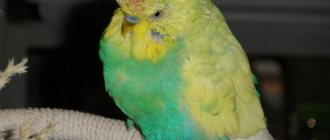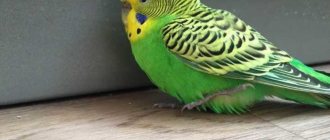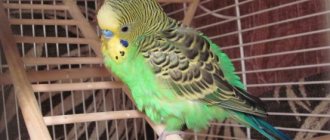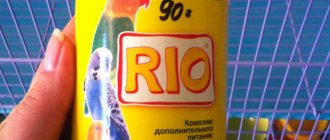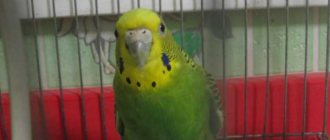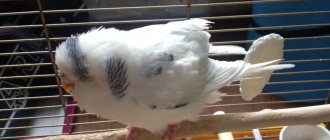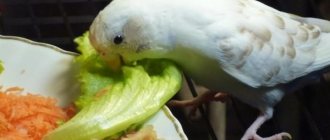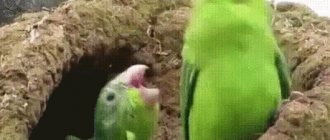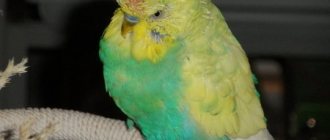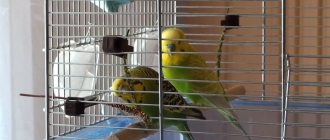Parrots are very cheerful and playful pets. They spend all their waking hours in motion. They chirp near the mirror, fly, and have fun with toys.
The activity and curiosity of the bird develops into affection for humans. In most cases, the person responds to the bird in kind, getting a lot of pleasure from spending time together. Beautiful cages, unusual toys, various islands of entertainment - all this makes it possible to observe her playful behavior.
But one day the owner notices a sharp drop in his pet’s playful mood. The bird loses its usual activity; it can sit for a long time on a perch or the bottom of the cage, ruffled. If we exclude diseases, then the state when the parrot is ruffled is a feature of its pastime.
During sleep, the parrot deliberately increases the volume of its plumage to better retain body heat. During the rest period, all physiological processes slow down, and the body loses precious heat. After awakening, the bird returns to active life again.
Diseases are the cause of the ruffled appearance
Unfortunately, very often the ruffled condition is accompanied by additional symptoms of the disease. At this moment, it becomes clear that changes are occurring in the pet’s body, the consequence of which is a decrease in body temperature. If the parrot is ruffled and sleeping, there is only one conclusion - the pet is sick.
Having discovered alarming signs, in order to avoid the neglect of the disease, you will need to identify the cause and begin treatment of the parrot. Studying symptoms and laboratory tests will provide a complete picture of the disease. If it is not possible to go to a specialized clinic, then treatment falls on the shoulders of the owner.
Possible diseases:
- Poisoning;
- Cold.
Causes not related to disease
Sometimes it happens that a completely healthy bird crests, trembles, and twitches its wings. This may be due to the following reasons:
- fear and stress;
- if the parrot freezes;
- with a lack of light;
- with a deficiency of vitamins and microelements.
STRESS IN THE PARROT // BUDGY PARROT TOSH // PARROT
Fear and stress
Fear usually arises during adaptation. The bird is in your home for the first time. New people, environments, sounds cause fear. To overcome the problem, do not frighten her with annoying attention, talk quietly and affectionately. Gradually the parrot will get used to it and everything will be fine.
The most common cause of stress is moving to a new apartment. The world familiar to the bird disappears, and a new, unexplored one appears. Give your pet the opportunity to get comfortable, and he will become the same.
The parrot is freezing
Birds are very sensitive to drafts and low temperatures. If your feathered pet is cold, turn on the table lamp.
Place it at a distance of half a meter from the cage, direct the light to the bottom. To retain heat, cover the remaining sides with thick fabric. But make sure your pet doesn't overheat.
The parrot is shaking
Lack of light
Lighting plays a very important role in the life of parrots. The fact is that they see ultraviolet light. Their perception of the world is brighter than human. With a small amount of ultraviolet rays, vision is impaired. Birds become lethargic, indifferent or irritable and angry. To increase sunlight, you can take the cage outside into the rays for an hour, an hour and a half, or walk with your pet using a special harness. You can also buy an ultraviolet lamp for additional lighting. It has already been proven in practice that with increasing ultraviolet radiation, the ability of parrots to reproduce increases.
Deficiency of vitamins and microelements
With monotonous feeding, vitamin deficiency may develop. Main features:
- lethargy and indifference;
- refusal to eat;
- the bird becomes ruffled and ruffled;
- the wings are trembling, the tail is tucked.
Trembling
To avoid such troubles, feed your pet a variety of foods, fresh fruits and vegetables are also needed.
Poisoning
The causes of poisoning can be various factors:
- Poor quality food and water with possible bacterial and fungal infections;
- Foods prohibited for consumption by parrots;
- Accidental consumption of poisonous indoor plants by a bird;
- Chemical poisoning: aerosol substances used by humans in enclosed spaces;
- Intoxication resulting from direct contact with low-quality feeders, drinkers and toys made using toxic materials;
If the parrot gets ruffled and vomits, this is obvious poisoning.
Symptoms of poisoning include vomiting, seizures, and changes in the concentration and color of droppings. With severe intoxication, loss of coordination may occur. In some cases, trembling and paralysis. It is very important to notice this problem at an early stage and begin treatment immediately.
Preventing stress and illness
Protecting a parrot from emotional turmoil and illness is not so difficult. It is necessary to equip the living space with all the amenities so that the pet feels comfortable and does not get sick. The interior of the cage should contain only high-quality items, and the space itself should not be cluttered. In cramped conditions with an abundance of equipment, it is easy to get injured, after which the bird will need treatment.
When keeping at home, proper nutrition is important. Buy proven mixtures for your parrot, do not forget about the vitamin complex. Avoid overeating and obesity. If you have any unclear symptoms, consult your doctor.
A parrot does not always tremble from fear or cold. Chills appear for various reasons: from simple vitamin deficiency to dangerous psittacosis. It is important not to miss symptoms, start treatment on time and conduct annual preventive examinations with a veterinarian.
Treatment
At home, the first step is to ventilate the room. Provides fresh air, especially in cases of chemical poisoning. Liquid adsorbent preparations are used using a pipette or medical syringe. These include Enterosgel, Polyphepan or activated carbon.
Thick preparations, as well as activated carbon, are diluted with purified water to the state of liquid sour cream. Using a syringe, 2-3 drops are instilled into the corner of the beak. After each drop, make sure that the parrot swallows it.
Drugs that cause a laxative effect are used. You can use fresh flax decoction. The laxative may cause mild distress. To prevent dehydration, birds need clean water at all times. If she refuses to drink, then forcefully feed her 3–4 drops into her beak.
If he refuses food, then complementary feeding is done with baby milk-free porridge through an insulin syringe. The feeding procedure is performed every 2 to 3 hours. The amount of porridge depends on the type of parrot.
What to do if the parrot gets ruffled?
Ornithologists give different recommendations, but we advise you to take a close look at the bird's current condition.
In the vast majority of cases, you will immediately notice other warning signs that were not observed before.
In particular, a parrot's eyes may be half closed, as if he does not have the strength to open them all the way.
Breathing may be hoarse and intermittent, well, let alone talk about the presence of diarrhea and vomiting, because it is simply impossible not to notice them. It is very likely that you will find a sharp decrease in the activity of the bird.
Instead of his favorite flights around the apartment, he will just sleep.
And sleep not somewhere on his perch, but at the very bottom of the cage, simply because he will not have the strength to rise higher.
In a word, the bird will demonstrate to you with its entire appearance that it is feeling bad and needs your help.
There are a number of diseases and other health problems that are accompanied by hunching.
These can be any infections that affect your pet's beak, paws, eyes, and ears.
A common cold, or even poisoning, is also possible. Well, apart are various diseases of internal organs, which can lead to the most severe consequences.
As you and I are already beginning to understand, the range of possible problems is simply enormous.
And since we don’t have the opportunity to wait and guess, because help must be provided to the bird as quickly as possible, it is necessary to urgently contact a veterinarian.
In a special hospital, the necessary tests will be done and the correct diagnosis will be made.
Colds
The homeland of parrots, in most cases, is hot countries (Africa, Australia, South America). Any, even seemingly short-term, ventilation of the room can cause colds in birds. The temperature regime must always be observed, depending on the type of parrot.
Cold air, drafts, and swimming in cold water are the causes of the disease.
Symptoms:
- ruffled appearance;
- lethargy and apathy;
- lack of playful and active mood;
- the appearance of heavy breathing or shortness of breath;
- sneezing;
- mucous discharge from the nostrils;
- sagging of the bird's tail to an almost vertical position.
If the parrot is ruffled and trembling, this is a clear sign of a cold. In this case, the bird may refuse to eat food and water.
Why does the parrot fluff and tremble?
No matter what kind of pet you have, be it a Gray, a cockatiel, a lovebird or a budgerigar, if it sits, ruffled, trembles, hides its head under its wing, it needs urgent help.
Reasons why a parrot flutters and trembles
The most common reasons for the unusual behavior of a feathered friend:
- fear;
- stress;
- cold;
- avitaminosis;
- disease;
- poisoning.
Signs and symptoms
Signs of non-dangerous and dangerous sources of unusual behavior of a feathered friend:
- hides his head under his wing;
- passive;
- sits at the bottom of the cage with his eyes closed;
- feathers bristle;
- trembling.
Common causes associated with diseases
Cheerful, cheerful pets sometimes get sick. The pathology can last only a few days and result in death.
Causes related to parrot disease
Diseases of parrots are divided into three groups:
- Infectious.
- Parasitic.
- Non-contagious, associated with poor living conditions and inadequate care.
Read also
How often should you wash a budgie's cage?
The most dangerous are infectious diseases:
- salmonellosis;
- mycoplasmosis;
- psittacosis or ornithosis;
- candidiasis;
- tuberculosis;
- aspergillosis.
Salmonellosis attacks the gastrointestinal tract. Infection causes intoxication of the entire body, affects the nervous system, and reduces vascular tone. The main signs of pathology: weakness of the parrot, severe diarrhea. After some time, the mucous membranes turn yellow, the paws turn blue, and the joints swell.
Causes and treatment: pathology develops when using food contaminated with bacteria, dirty egg shells or poor-quality water. Treated with antibiotics. Without proper treatment, death is possible.
Infectious diseases in parrots
Important! Salmonellosis is dangerous for humans.
Mycoplasmosis is transmitted by airborne droplets. The following signs are characteristic: sneezing, shortness of breath, liquid discharge from the nostrils, decreased appetite, the bird is inactive, apathetic. The parrot sits disheveled and often closes its eyes. The feathers around them become wet. Mycoplasmosis is not dangerous for humans.
Candidiasis develops as a result of decreased immunity, long-term treatment with antibiotics and poor nutrition. It affects various organs and therefore the symptoms differ significantly: respiratory failure, the appearance of a whitish coating on the mucous membranes, loss of appetite, regurgitation of eaten food, lethargy, drowsiness. Does not pose a danger to humans.
Tuberculosis is transmitted by airborne droplets, sometimes through food or feces. The disease is long-term and symptoms do not appear immediately. Affects the respiratory system, bones, gastrointestinal tract, skin. Symptoms: heavy breathing, diarrhea, joint deformation, skin tumors, anemia, nodules on the mucous membranes.
Aspergillosis has no obvious symptoms. Only wheezing and heavy breathing are noticeable. The bird loses weight, the feathers become dull and lifeless. Lethargy and inactivity accompany the disease.
Symptoms of various infectious diseases in a parrot
Important! Humans can also get this disease. If left untreated, damage to the nervous and respiratory systems occurs. The infection is transmitted by air.
Cold
Non-contagious ailments most often include colds and poisoning.
Colds can occur if your pet's cage is in a draft. Parrots can't stand it.
Symptoms of the disease:
- labored breathing;
- runny nasal discharge;
- sneezing;
- diarrhea;
- conjunctivitis;
- the bird is tufted, hiding its head under its wing.
Parrot diseases.
Mite or dryness in a budgie. Prevention and treatment of #birds The main thing they do is block access to the draft. If the room temperature is below 22 C, turn on a table lamp for additional heating. The light is directed onto the cage, part of which is covered with a towel. To prevent overheating, the pet is closely monitored. As soon as he begins to breathe frequently, the lamp is turned off. The procedure is carried out 2-3 times a day, avoiding overheating.
In addition to warming up, you can perform inhalation, give water with an antiseptic, and give antibiotics.
Inhalation is done like this: add 2-3 drops of eucalyptus oil and a little “Zvezdochka” balm into a small container, pour boiling water over it, and place it near the cage for 30 minutes. In this case, you need to carefully monitor your pet’s behavior. If the condition worsens, the procedure is stopped.
Instead of water, give the bird a cooled chamomile decoction. Prepare according to the instructions included with the dry herb package. Due to the fact that the medicine deteriorates quickly, it is changed every 2 hours.
Baytril is the most commonly used antibiotic. Use a pipette to pour a drop of the drug into the beak, once a day, for 5 days.
